For English version scroll down
El tren a Selçuk, la ciudad donde está Éfeso, fue bastante agradable y rápido. Pasamos el tiempo viendo una película en el ordenador y hablando con nuestro nuevo amigo turco. Cuando estábamos en la sala de espera de la estación de tren un niño de unos 5 años le resultamos curioso que no fuéramos de allí y comenzó a hablar con nosotros… en turco, y yo contestándole en gallego. Así seguimos un rato hasta que comenzamos a jugar al solitario con el ordenador. Cómo él también embarco en el tren con la abuela de vez en cuando venía a visitarnos y ver lo que estábamos haciendo y seguir hablando con nosotros. Un encanto el niño y eso que no tenemos ni idea de lo que nos decía, pero no paraba de hablar como una cotorra, creo que lo máximo que pudo sacar de nosotros fue nuestro nombre y de donde éramos porque se lo enseñamos en el mapa.
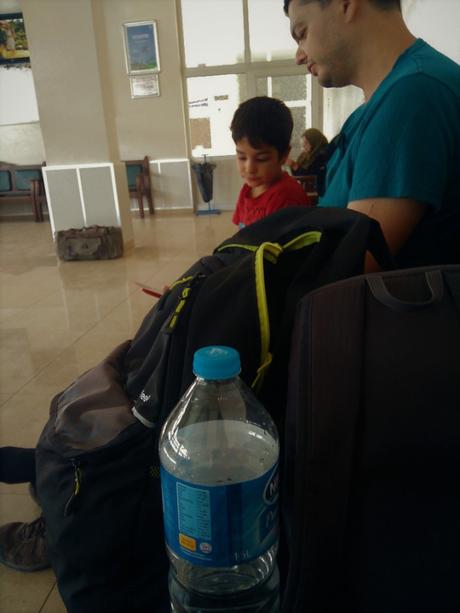
Concentrados en el solitario – Focussed on the solitaire
Selçuk es un pueblecito bastante pequeñito y no es muy difícil orientarse, además que en Turquía están muy enfocados al turismo así que tienes casi todo señalizado. Nada más salir de la estación de tren ya había señales para ir a diferentes sitios turísticos, en nuestro caso comprábamos una vez más con maps with me app para ver donde quedaba la casa de huéspedes (lo bueno que tiene esa app es que se conecta con la página de booking y así podíamos buscar la ruta a seguir)
Cuando íbamos caminando a nuestra casa de huéspedes, nos preguntaron si éramos Australianos. Australianos, eh? Con ese acento español que tengo en inglés que chirría nada más hablarlo… Lo curioso es que nuestra casa de huéspedes se llamaba ANZ (Australia, New Zeland) y para más sorpresas nuestra compañera de dormitorio también era Australiana, al menos algo de relación teníamos con Australia 🙂
La casa de huéspedes era bastante tranquila, con un patio muy acogedor y una vista desde la terraza muy bonita, además el desayuno era en plan buffet, ñan ñan 🙂 Como ya era bastante tarde ese día no salimos excepto para comer nuestro “luncher” (como el “brunch”, pero la comida entre el almuerzo y la cena) a un lugar bastante cercano que habíamos visto en foursquare, y que resultó que el dueño de la casa de huéspedes nos había recomendado también, y la verdad que estaba muy rico.
Al día siguiente era nuestro “gran día” viendo Éfeso, para ir allí o una de dos o coges un taxi, o alquilas una bicicleta o coche o como nosotros caminas que es la opción más sana y barata. Desde donde estábamos tardamos unos 30 40 minutos caminando, y sin contar que acabamos perdidos y fuimos a visitar primero la iglesia de San Juan. Una vez orientados y esta vez en la dirección correcta fuimos paseando por la “avenida peatonal” que fue creada para conectar Selçuk con Éfeso, aunque eso fue hace más de 50 años y parece ser que no lo han vuelto a mantener o renovar desde hace una temporadita. Por el camino te encuentras un desvío para ver el templo de Artemisa, el cual dejamos de lado para verlo después a la vuelta, ya que empezaba a calentar y no queríamos estar en las peores horas del día al sol.
Cuando llegamos finalmente a Éfeso tuvimos que evitar todos los pesados guías que nos querían dar un tour guiado por la ciudad y los vendedores de, textualmente, copias auténticas de relojes (es decir falsificaciones) y demás baratijas y suvenires. A todo esto en la entrada también nos “atacaron” taxistas o conductores de carruajes que nos ofrecieron llevarnos después de vuelta. Algo que tienen muy estudiado es como entablar conversación con la gente y lo primero que hacen es preguntarte de dónde eres, así que para tener unos pocos minutos para desubicarlos decíamos que éramos de Rumanía, o que veníamos de República Checa, así no tenían tiempo de pensar algo de esos países antes de irnos. Con España no funciona ya que te empiezan a hablar de futbol, Barcelona, Madrid… Así pues el truco desubicarlos y sigues con paso rápido.
En la entrada de Selçuk teníamos la opción de comprar una entrada “combo” para varios museos y zonas de interés o sólo para Éfeso, después de contar más o menos donde nos interesaría entrar y el coste total del combo y de entradas separadas, decidimos coger sólo para Éfeso.
Una vez dentro decidimos ir al final de la ciudad sin pararnos a ver en detalle los monumentos y después ya de vuelta realmente empezar a prestar atención, el motivo de esto es bastante simple en esos momentos había varios grupos y la zona Sur de la ciudad estaba abarrotada de gente, como al ir con guía sabíamos que los iban a despachar muy rápido en 30 minutos o máximo una hora, fuimos a la parte menos visitada, pero igual de impresionante y a la vuelta estaría más libre, ya que sería la hora de comer y no se lo podrían saltar de su programa.
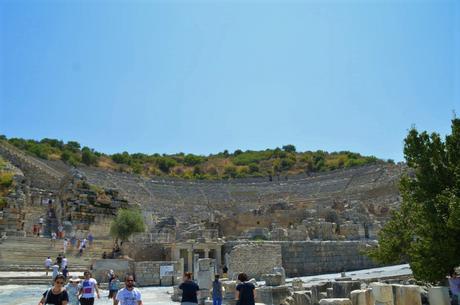
Teatro en Efeso – Ephesus theater
Nada más entrar en la ciudad tienes la vista del teatro en todo su esplendor, el cual en el pasado conectaba con un paseo que daba directamente al mar, que hoy en día queda bastante lejos del emplazamiento original debido a la erosión. Según vas siguiendo continúas viendo los diferentes edificios típicos de una ciudad romana, como puede ser el foro, paseos porticados, insulaes, la biblioteca (uno de los símbolos de Éfeso), un odeón, el nimphaneo, columnas conmemorativas, termas, y un gran etcétera. Todo ello con un lujo de detalle que te hace pensar como de impresionantes tendrían que ser las ciudades por aquellos tiempos. A todo esto si le añadimos la tecnología que tenían y los materiales de construcción por aquella época. Realmente cuando hacían algo lo hacían a lo grande. Al final entre una cosa y otra nos pasamos casi tres horas allí, y eso que no estuvimos a leer todos los carteles o no visitamos algunas partes, principalmente porque andaba un poco tocado por la venganza del sultán (entiéndase diarrea), ya desde Pamukkale y las fuerzas se iban por donde se iban. Así que después de sentarnos un rato en el teatro nos fuimos de vuelta a descansar a comer algo y descansar en nuestro alojamiento el resto del día.

Mirando al mar imaginario, Efeso – Looking to the imaginary see, Ephesus
Al día siguiente teníamos como plan o irnos al pueblo de Sirince o a la playa de Pamucak los cuales están a 10 y 5 km de Selcuk, el primero es un antiguo pueblo griego, que recuerda bastante a la campiña Italiana, y el segundo pues una playita poco turística pero que haría las delicias. Antes de decidirnos a donde ir, comprobamos el email y para sorpresa mi e-visa para India tenía algún problema, así pues nos pasamos casi media mañana tratando de resolver el problema y para cuando ya lo teníamos era bastante tarde para ir a cualquier lado, así que decidimos dedicar ese día a la logística del viaje (comprar billetes de autobús/avión, alojamientos, cuentas…) y seguir recuperándome del estómago. Por la noche fuimos a dar un paseo por Selçuk y comer algo por la zona del acueducto. Encontramos un sitio que estaba muy bien, y se comía de lujo, debería ser que el dueño no llevaba una buena racha, ya que la terraza estaba vacía. Así que muy avispado nos puso donde nos pudiera ver la gente y nos empezó a traer algunos entrantes gratis para que otros turistas vieran y cómo nos pusimos las botas. Nos trajo una “especie de pan” recién horneado gigantesco con unas salsas para ir mojando, acompañados de unas aceitunas negras maceradas. Riquísimo, no habías tenido nuestra comida y ya estábamos llenos 😮 Nuestra comida tampoco decepcionó en mi caso bastante sencillito chuletas de cordero con arroz y Ale pinchos morunos de pollo.
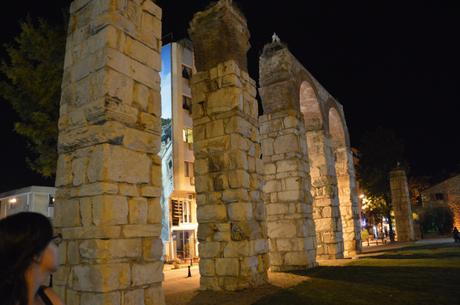
Acueducto – Aqueduct
Desde Selçuk nos fuimos a Çanakkale, lugar cerca de la mítica Troya y lugar de la batalla de Gallipoli durante la primera guerra mundial (y donde Ataturk comenzó a hacer sus pinitos como militar al mando). Esta vez escogimos el autobús de la compañía Kamil Koç para ir hasta Çanakkale, de nuevo porque tenía un minibús que te llevaba desde las afueras, donde se encontraba la estación de autobuses (en este caso estaba fuera de la ciudad, al lado de la autovía), hasta el mismísimo centro. En nuestro caso incluso casi enfrente del hotel. El viaje de por si es bastante largo y se tarda más de 8 horas en llegar al destino, obviamente con paradas y también recibiendo bebidas gratis y tentempiés del asistente de autobús 🙂
Llegamos ya de noche y fuimos a hacer el check in y nos fuimos a comer algo por la zona. Algo que nos llamó la atención es que antes de salir del hotel cuando le preguntamos donde ir a comer, él nos indicó que no fuéramos en una dirección que era peligroso para nosotros… la misma dirección por la cual había un río de gente caminando sin parar, de nuevo me remito a este post. Si bien esta vez seguimos su consejo ya que nos dijo que había más sitios para comer por la otra dirección, porque si no íbamos a seguir a la gente. Una vez comidos fuimos a ver la estatua del caballo de Troya. En este caso cuando se hizo la última película de Troya con Brad Pitt y Eric Bana, entre otros, los productores decidieron donar la estatua usada en la película a la ciudad de Çanakkale, la cual lo tenía expuesto en el puerto junto con una breve historia de la ciudad de Troya y una maqueta.
La visita a Çanakkale iba a ser en plan relámpago, ya que íbamos a pasar sólo esa noche y al día siguiente teníamos a media noche el autobús de vuelta a Estambul. Nuestro principal objetivo (más bien el mío) era ver Troya e imaginarnos los lugares donde la Iliada tuvo lugar con sus héroes clásicos. Para eso teníamos dos opciones o coger un tour, donde también nos podrían empaquetar con calzador el mismo día Troya y Gallipoli (el cual está en la parte opuesta del estrecho de los Dardanelos) o ir por nuestra cuenta a Troya. Por regla general soy un poco reacio a coger guías cuando se tratan de sitios históricos relacionados con la antigüedad clásica y con las guerras antiguas, debido a mis conocimientos sobre ellas y porque disfruto más teniendo libre para explorar por mi cuenta. Así pues como teníamos todo el día para estar a nuestro aire y no teníamos mucho interés en ver las trincheras de Gallipoli y monumentos conmemorativos, nos decidimos a ir por nuestra cuenta a ver Troya.
Desde Çanakkale tienes minibuses que van a Troya, si vas los días de diario salen cada hora, si vas un fin de semana, como en nuestro caso el horario es más largo y no tan frecuente. En nuestro caso cuando llegamos el minibús ya había salido y tuvimos que esperar una hora y media, con ese tiempo lo que hicimos fue ver el mercado local que estaba al lado de la parada de autobús, pasear un poco y actualizar los costes del viaje. El viaje dura más o menos 40 minutos y te deja delante mismo de la entrada de Troya.
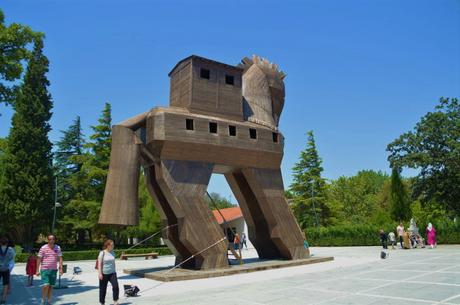
Caballo de Troya en Troya – Trojan horse in Troy
Lo primero que ves nada más entrar es la estatua del caballo de Troya, si, otra estatua. En este caso hecha por un artista Turco en homenaje a los protagonistas de la Iliada. Como niños pequeños, al menos yo, subimos al caballito para ver las vistas desde allí. Una vez pasados el momento tonto J nos fuimos a ver las ruinas, las cuales son muy interesantes, ya que no existe una única Troya si no las ruinas de nueve diferentes ciudades construidas unas sobre otras. Todo un reto para el primero que descubrió Troya, Heinrich Schliemann, allá por el año 1870, el cual al no saberlo se puso a hacer una trinchera para llegar al último nivel destruyendo partes de las otras ciudades. Lo curioso es que buscaba la mítica Troya y cuando llegó al último nivel ya se había cepillado parte de la Troya de Homero. Curiosamente haciendo esto consiguió encontrar un montón de objetos valiosos, a los cuales les llamó el tesoro de Príamo (aunque este personaje, en el caso de que existiera, habría vivido unos 300 años más tarde. Más o menos la misma diferencia cronológica que nos separaría hoy en día de Napoleón, casi nada). Afortunadamente se dio cuenta de su error a hacer esa trinchera y no siguió la misma técnica con el resto de la ciudad.
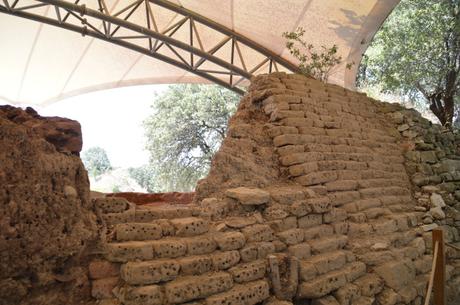
En el recinto tienes varias indicaciones que te ayudan a distinguir los diferentes niveles. Si eres un apasionado de la historia es un sitio al cual vas a disfrutar como un loco, ver las diferentes construcciones, imaginarte lo impresionante que deberían de ser las murallas, ver los diferentes extractos y pensar que diferentes personajes históricos pasaron por alguna parte diferente de la ciudad, para homenajear a Aquiles, Héctor, Ulises… Cómo por ejemplo Alejandro Magno en su camino para conquistar el imperio Persa, o Marco Antonio y Cleopatra. La primera ciudad de Troya se estima que se formó por el año 3000 2500 AC y permaneció ocupada casi sin interrupción hasta la época bizantina.
La parte excavada que se puede ver es bastante pequeña, pero aún así nos pasábamos un rato largo en el recinto. Curiosamente en todo el tiempo que estuvimos allí nos pasaron más de tres tours completos, así pues en este caso no me arrepentí de no haber usado el fast food de la cultura con los tours y tener mi tiempo para explorar por mi cuenta y ver diferentes partes de la ciudad, además de hacer de guía turístico a Ale.
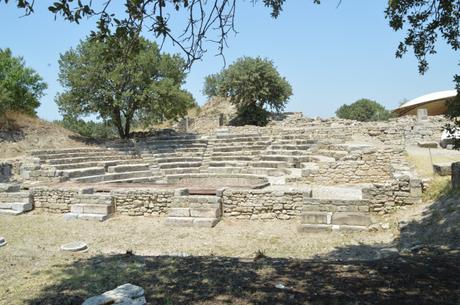
A la vuelta de Troya esperamos nuestro minibús a la salida, pero sin saber el porqué, una vez dentro del mismo tuvimos que hacer un transbordo en el pueblecito al lado de Troya, de repente toda la gente empezó a salir del mismo y se metieron en el otro, como nuestro dominio del idioma turco estaba por aquella al mismo nivel que el mar muerto, usamos la técnica de la oveja: sigue al grupo.
Una vez de vuelta en Çanakkale nos fuimos a comer Kokorec, que es un bocadillo de tripas de cordero, no suena apetitoso, pero está de vicio. Ya una vez con el buche lleno nos fuimos a dar una vuelta por la ciudad, ya que el autobús era a la una de la noche desde el centro de la ciudad.

Biblioteca – Library

Entrada a la biblioteca – Entry to the library
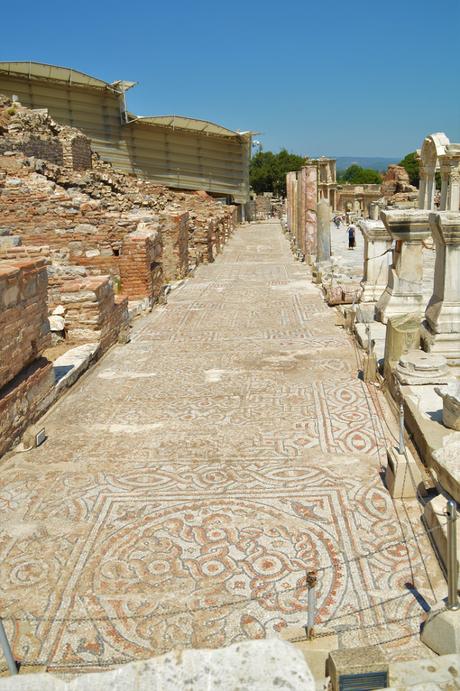
Mosaicos
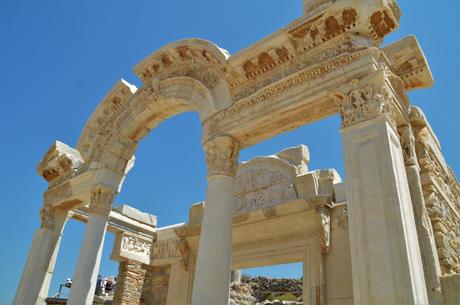
Nimphaneum
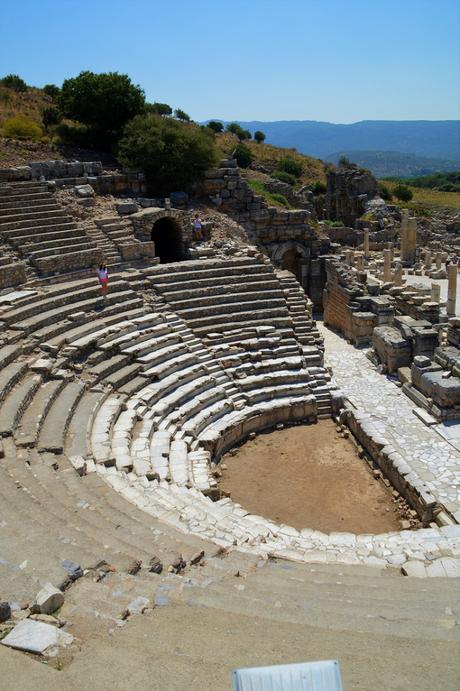
Odeom
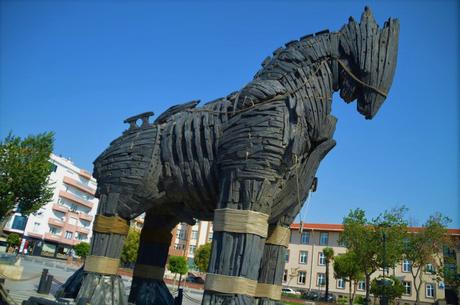
El caballo de la pelicula – The movie horse
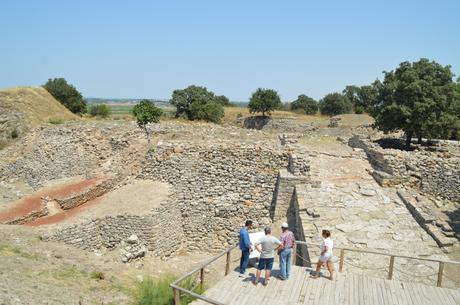
Rampa de entrada – Entrance rampant
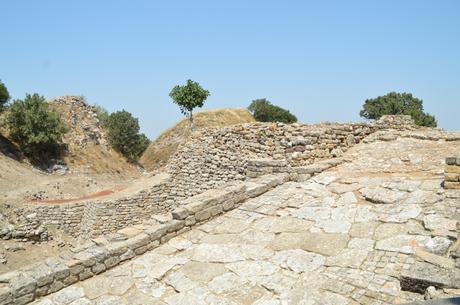
Entrada sur – South entrance
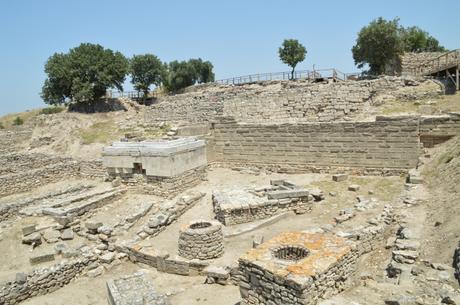
Ruinas de un altar romano – Ruins of roman altair
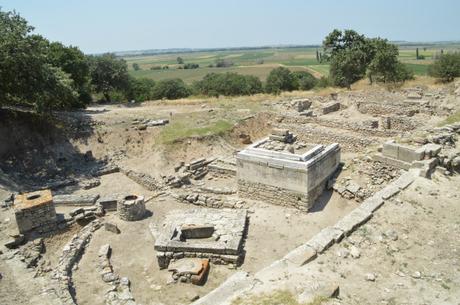
Troya Greco – Romana – Greek Roman Troy
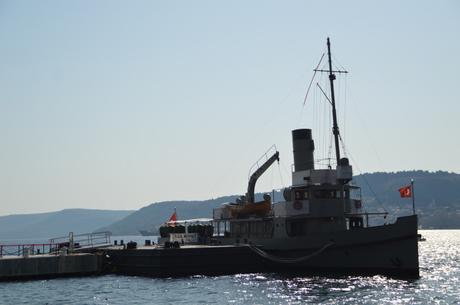
Replica dragaminas Nusret I GM – Replica Nusret Minesweeper WWI
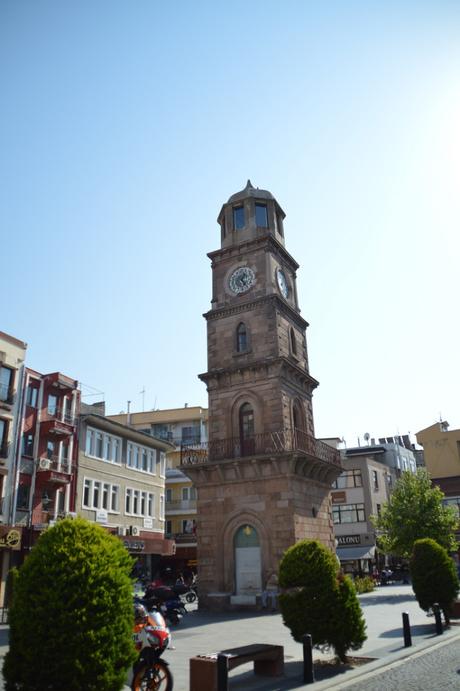
Torre del reloj – Clock tower
The train to Selçuk, the city where Ephesus is located, was quite pleasant and fast. We spent the time watching a movie on the laptop and talking to our new Turkish friend. When we were in the waiting room, a 5 year old boy found it interesting that we were not from there and he started to talk to us… in Turkish, and I was replying in Galician. We went on like this for a while until we started to play Solitaire on the laptop. Since he also took the same train with his grandmother, he was coming from time to time to visit us and see what we were doing and talk to us. He was a very nice kid and we had no idea what he was telling us, but he did not stop talking, I think that the most he could get from us were our names and where we were coming from, because we showed him on the map.
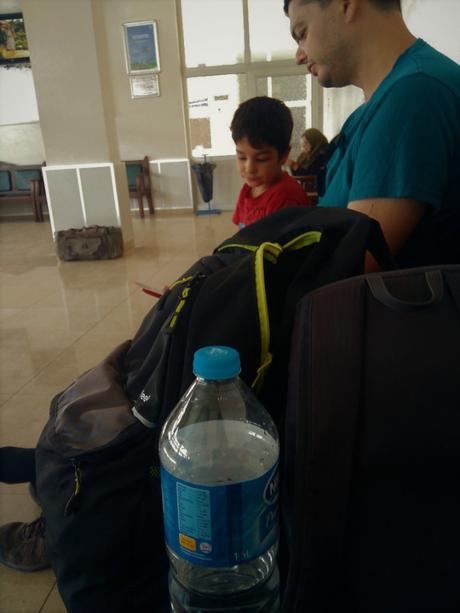
Concentrados en el solitario – Focussed on the solitaire
Selçuk is a pretty small village and it is not very difficult to get around; besides this, Turkey is very focused on tourism, so almost everything is well indicated. We just got out of the train and we saw signs for going to different touristic sites, but in our case we checked again the Maps with me app, to see where our guesthouse was located (one of the good things about this app is that it connects to the Booking.com app and we could search for the way to the guesthouse).
When we were walking towards our guesthouse, they asked us if we were Australians. Huh? Australians? With my Spanish accent… The interesting thing was that our guesthouse was called ANZ (Australia, New Zealand) and our roommate was also from Australia, so we had at least some connections to AustraliaJ.
The guesthouse was quite calm, with a very welcoming garden and a very nice view from the terrace, and besides this we had a buffet breakfast, yum yum J. Since it was quite late we just went out to have our “luncher” (like brunch, but the mix between lunch and dinner) to a place that was close, that we found on Foursquare and that, by chance, was also recommended to us by the owner of our guesthouse, and the truth is that the food was very tasty.
Next day was our “big day” visiting Ephesus; in order to get there, you have the option to take a taxi, to rent a bike or a car or, like us, walk and this will be the cheapest and healthiest option. It took us 30-40 minutes to get there from our guesthouse, including getting a bit lost and a short visit to St. John´s church. Once we got on the right way, we walked on the “pedestrian avenue”, which was created precisely to connect Selçuk to Ephesus, but this was more than 50 years ago and it seemed like they had not been taking care of it nor renovating it for some time. On this way to Ephesus, you find a detour to the Temple of Arthemis, that we were planning to see on our way back, given that it was already getting hot and we did not want to be in the sun in the worst time of the day.
When we finally arrived to Ephesus, we had to avoid all the annoying guides that wanted to give us a tour and the sellers – who were literally selling “genuine watch replicas” (meaning fakes) and souvenirs. Besides this, at the entrance we were “attacked” by the taxi drivers who wanted to take us back after the visit. They have a strategy for starting the conversation with the people and the first thing they ask is where you are from, so in order to confuse them a bit, we were telling them we are from Romania or Czech Republic, and this way they did not have time to find a topic related to these countries and we could just leave. This did not work if we said that one of us was from Spain, because they started to talk about football, about Barcelona, Madrid… The trick is to confuse them and leave fast.
At the entrance to Ephesus we had the option to buy a “combined” ticket and see other museums and sites or just a ticket to Ephesus, so after reviewing what we wanted to see and comparing the price of the “combined” ticket and the separate tickets, we decided to buy only the one for Ephesus.
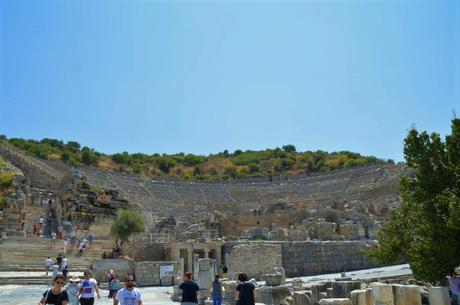
Teatro en Efeso – Ephesus theater
Once we went in we decided to go until the end of the city without stopping to see the monuments in detail and to pay attention only on our way back, due to the fact that at that time there were many guided tours and the South part of the city was full of people. Since we know that the guided tours are quite fast and they would have finished in 30 minutes or one hour, we went to the least visited part, which is equally impressive, and we were counting on the fact that on our way back there will be less people, given as well that it would have been lunch time and some people have to keep their schedule.
Right at the entrance you can see the theatre in all its glory; in the past, this theatre was connected to the sea through an alley – nowadays, the sea is quite far due to the erosion. Following the way to the city, you will see the various buildings, typical for a roman city, like the Forum, the Colonnade alley, insulaes, the library (one of the symbols of Ephesus), the Odeon, the Nymphaneum, commemorative columns, thermes and a big etcetera. All these buildings have amazing details and it makes you think how impressive the cities were during those times. Not mentioning the technology they had back then and the materials they were using for the constructions. When they were doing something, the result was magnificent. In the end, while we were amazed by the place, we spent there almost three hours and this without reading all the boards or visiting all the places, mostly because I was a bit touched by the Sultan´s revenge (meaning diarrhea) since Pamukkale and I was weak because of this. After a quick stop in the theatre, we went back to have lunch and rest in our guesthouse.
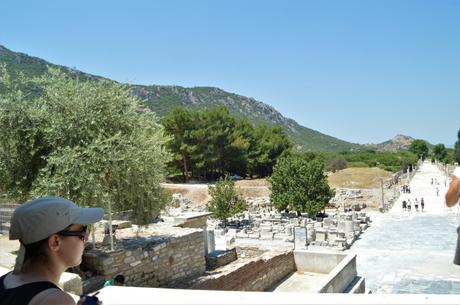
Mirando al mar imaginario, Efeso – Looking to the imaginary see, Ephesus
We had planned a trip to the small village of Sirince for the next day, or a quick trip to the beach in Pamucak, both being at 10 and 5 km distance from Selçuk. The first one is an old greek village, that reminds of the Italian villages, and the second one is a less touristy beach that would have been worth the trip. Before deciding where to go, we just checked the email and I was surprised to see that there was an issue with my Indian e-visa, so we spent almost all morning trying to solve it and by the time everything was done, it was too late to go somewhere, so we decide to spend the day taking care of the logistics (buying the bus/plane tickets, accommodation, reviewing the budget…) and I was still recovering from my stomach issue. During the evening we went for a walk and we ate something in the area close to the aqueduct. We found a nice place with very good food, but it seems that the owner did not have good luck this night, because the terrace was empty. He was very clever and he seated us at a table where the people passing by could see us and he started to bring us some free starters, so that other tourists see us eating them. He brought us a huge “sort of bread” fresh out of the oven and some dips, together with marinated olives. Very tasty, we had not received our meal and we were already full :O. The main dish did not disappoint us either, in my case it was quite simple, some lamb chops with rice and Ale had chicken skewers.
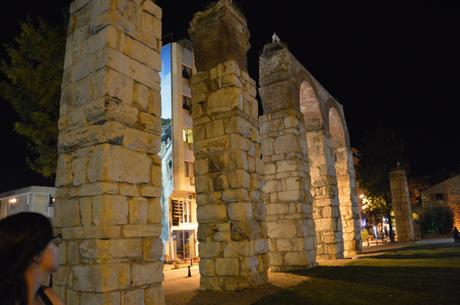
Acueducto – Aqueduct
From Selçuk we went to Çanakkale, a city close to the mythical Troy and to Gallipoli, where the battle took place during the First World War (and where Ataturk started to be noticed as a military man in charge). This time we chose the bus from Kamil Koç to go to Çanakkale, again because it had a minibus that was taking us from the outskirts, where the main bus station was (outside the city, close to the highway) to the city centre. In our case, precisely in front of the hotel. The trip itself is quite long, it takes 8 hours to arrive to the destination, obviously with a few stops and also receiving free drinks and snacks from the bus attendantJ.
We arrived during the night so we went to do the check in and eat something close by. Something that got our attention was what the receptionist told us when we asked for recommendations about food – he told us not to go to one direction, because it would be dangerous for us… the same direction from where many people were coming, I am again coming back to this post. This time we followed his advice because he told us that there were more places to eat in the other direction, if not we would have followed the people. After dinner, we went to see the horse of Troy. In this case, when they made the last movie Troy, with Brad Pitt and Eric Bana among others, the producers decided to donate the statue they used in the movie to the city of Çanakkale, exhibited in the port, together with a short history of Troy and a scale model of the ancient city.
The visit to Çanakkale was supposed to be quick, because we were spending only one night in the city and next day we had the bus to Istanbul, at midnight. Our main goal (or more mine) was to see Troy and imagine the places where Illiad, with its classic heroes, took place. We had two options for the visit: take a tour, where they could have taken us very fast to Troy and Gallipoli (which is on the opposite side of the Dardanelles strait) or go on our own to Troy. Generally, I am a bit skeptical about guides when we go to visit historical sites, related to the Antiquity and to the ancient wars, due to my knowledge about this topic and because I enjoy more exploring on my own. Since we had all day to enjoy Troy and we were not very interested in seeing the trenches of Gallipoli and the commemorative monuments, we decided to go on our own to Troy.
There are minibuses from Çanakkale to Troy, on working days they leave every hour, during the weekend the schedule is different and they don´t leave so often. We were there on a Sunday and when we arrived to the station, the minibus had already left, so we had to wait for one hour and a half. To pass the time, we went to see the local market that was close to the station, have a walk and update the costs of the trip. It takes 40 minutes to arrive to Troy and the bus leaves you exactly in front of the entrance.
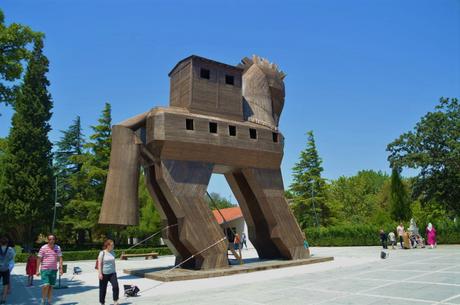
Caballo de Troya en Troya – Trojan horse in Troy
The first thing you see at the entrance is the statue of the horse of Troy, yes, another statue. This one is made by a Turkish artist as a tribute to the characters of Iliad. Like little children, we went up inside the horse, curious about the views from up. After this silly moment J we went to see the ruins, which are very interesting because there is no such thing as a unique Troy, but the ruins of nine different cities built one on top of the other. A big challenge for the first person who discovered Troy, Heinrich Schliemann, around 1870; without knowing, he started to make a trench in order to get to the last level, destroying this way part of the other cities. What is interesting is that he was looking for the mythical Troy, but when he reached the last level, he had already destroyed part of Homer´s Troy. However, by doing this he managed to find many valuable objects that he named the treasure of Priamo (although this character, if he ever existed, lived 300 years later. More or less the same difference between us en the times of Napoleon, almost nothing). Fortunately, he realized the huge mistake he made with the first trenches and he didn´t use the same technique for the rest of the city.
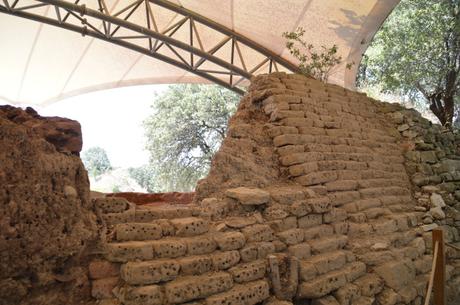
There are many signs in the complex that help you distinguish the different levels. If you are passionate about history, you will truly enjoy this place, seeing the different constructions, imagining how impressive the walls were, seeing the ruins and thinking that different historical characters passed by the city to bring a tribute to Achiles, Hector and Ulysses… Like Alexander the Great, for example, on his way to conquer Persia, or Mark Anthony and Cleopatra. It is estimated that the first city of Troy was formed around 3000-2500 BC and it stayed occupied almost without interruption until the byzantine era.
The excavated part that can be seen is quite small, but even like this we spent a few hours there. Strangely, during our visit, we saw more than three complete guided tours passing by, so I did not regret not using the cultural “fast food” that are the tours and taking my time to explore and to see the different parts of the city, besides being also a guide for Ale.
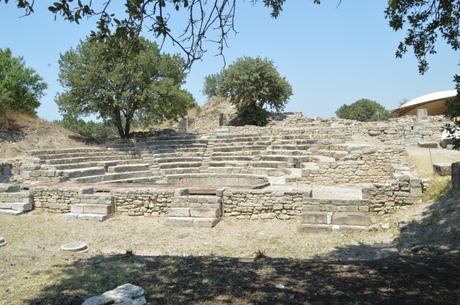
Odeom en Troya, Troys odeom
For the way back, we waited for the minibus in front of the entrance, but without knowing why we had to change the bus in a small village close to Troy, suddenly everybody started to go out of our minibus and into the other one, so with the same level of Turkish as the Dead Sea, we used the sheep technique: follow the crowd.
We got back to Çanakkale and we went to eat Kokorec, which is a sandwich with lamb tripe, I know it does not sound appetizing, but it is very tasty. Full and happy, we went to have a walk around the city, given that our bus was at one in the night and we were supposed to pick it up from the city centre.
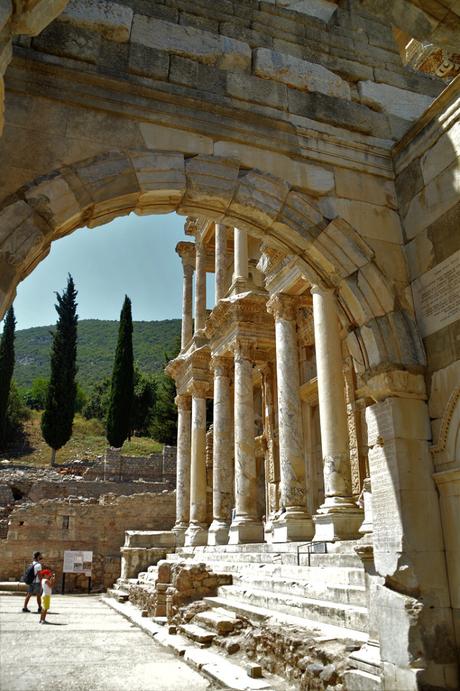
Biblioteca – Library
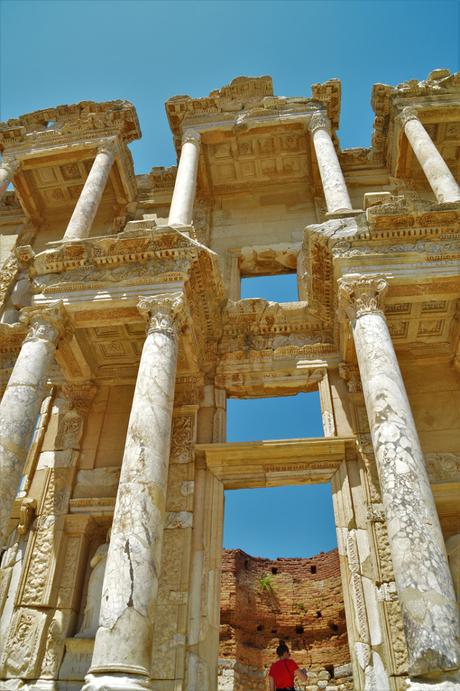
Entrada a la biblioteca – Entry to the library
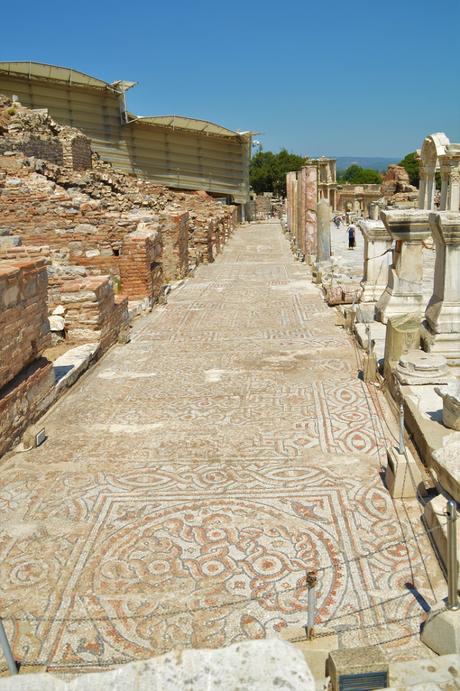
Mosaicos
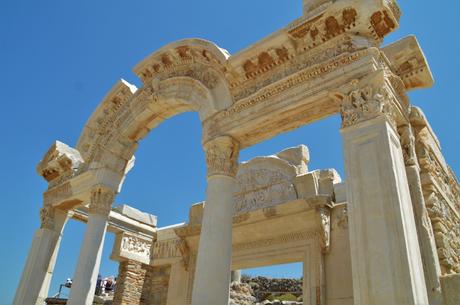
Nimphaneum
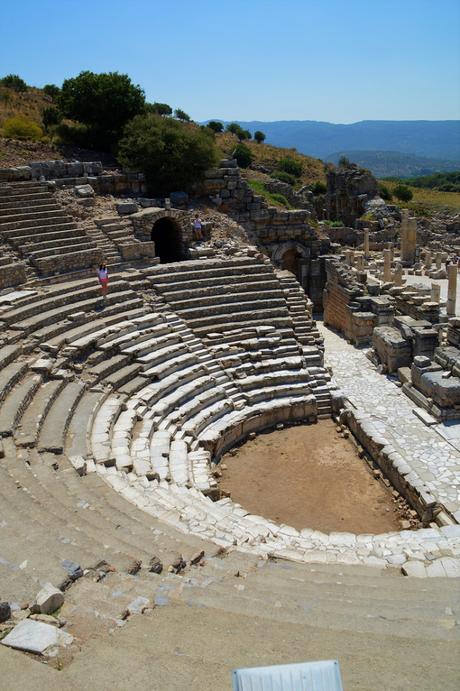
Odeom
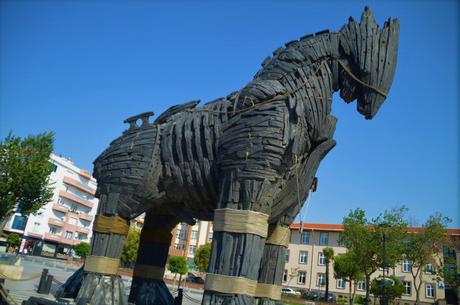
El caballo de la pelicula – The movie horse
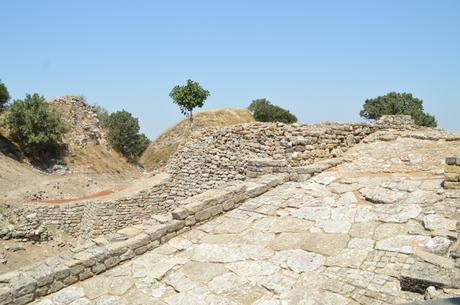
Entrada sur – South entrance
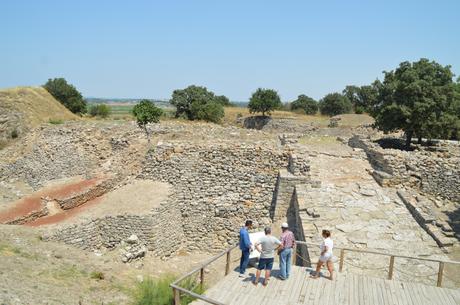
Rampa de entrada – Entrance rampant
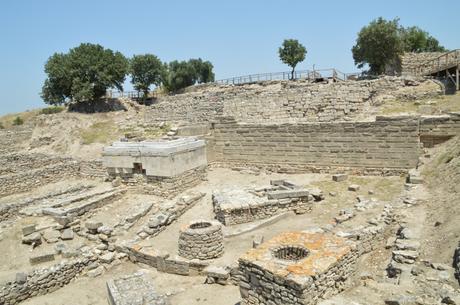
Ruinas de un altar romano – Ruins of roman altair
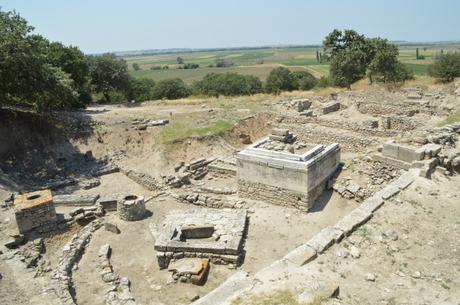
Troya Greco – Romana – Greek Roman Troy
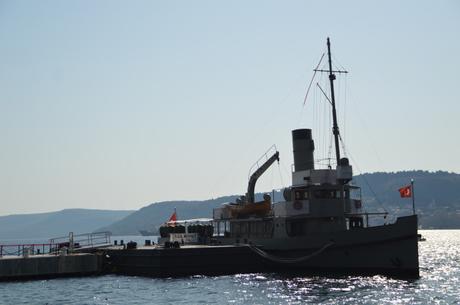
Replica dragaminas Nusret I GM – Replica Nusret Minesweeper WWI
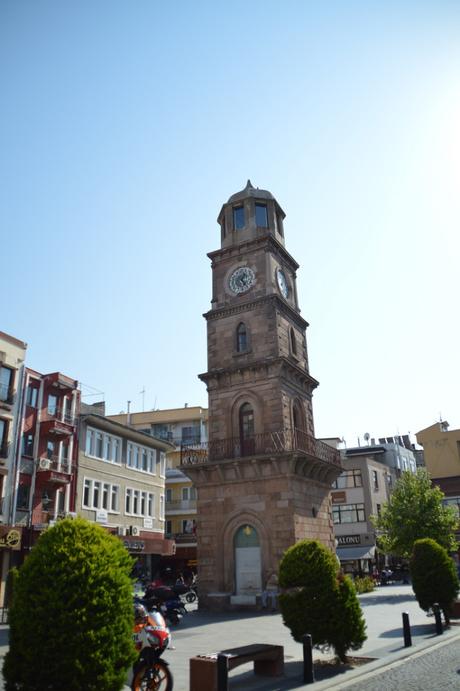
Torre del reloj – Clock tower
Anuncios